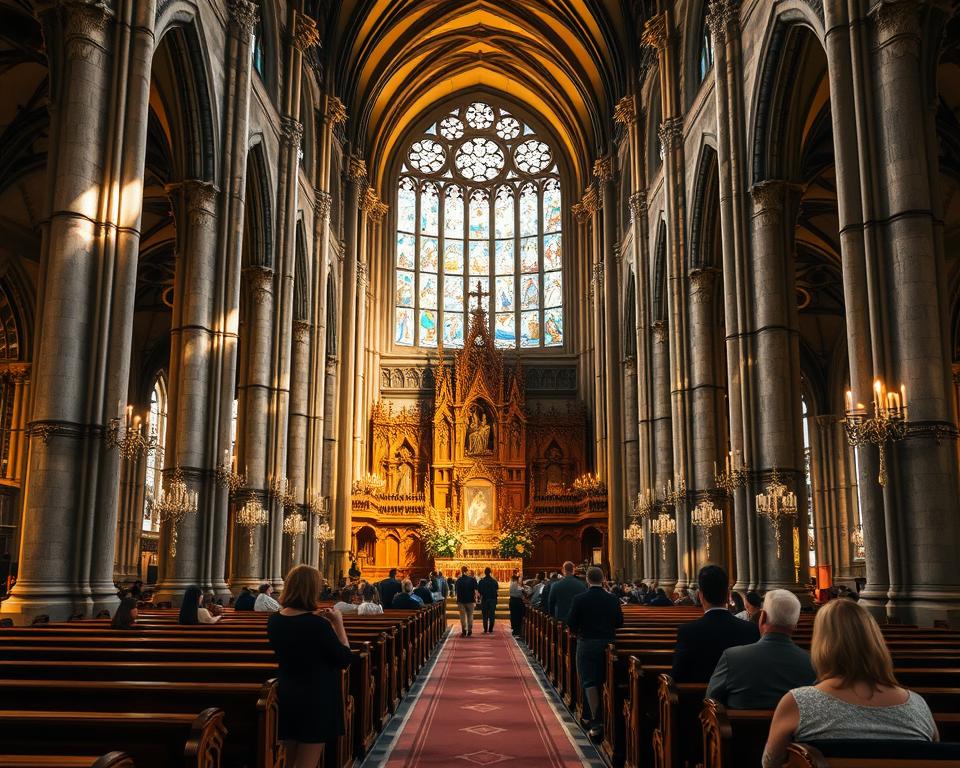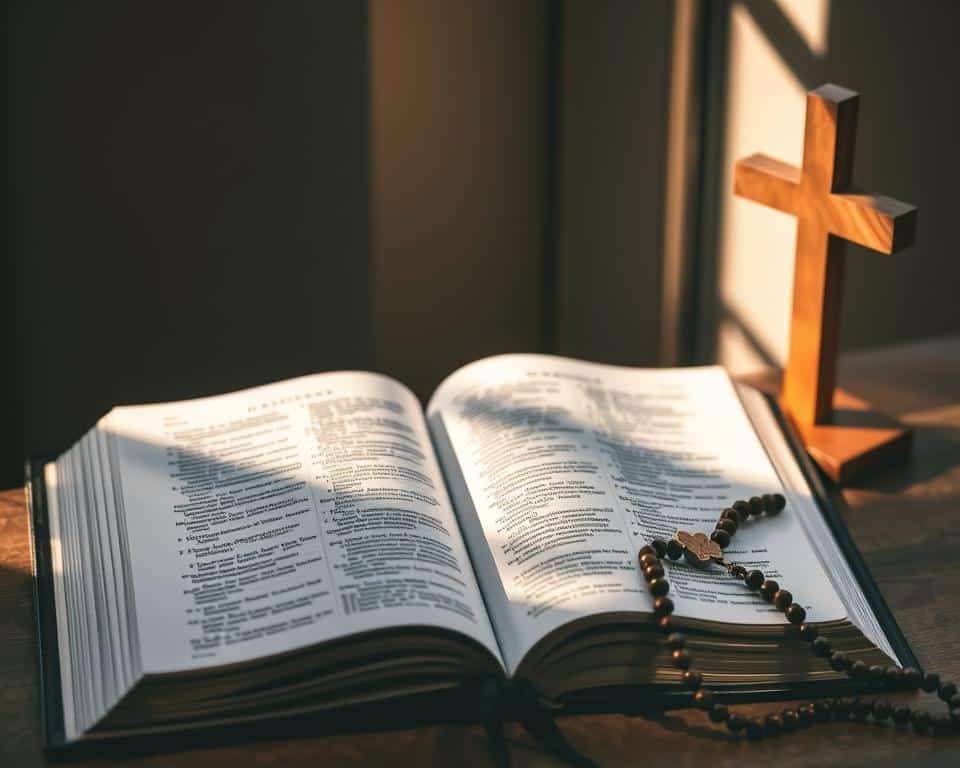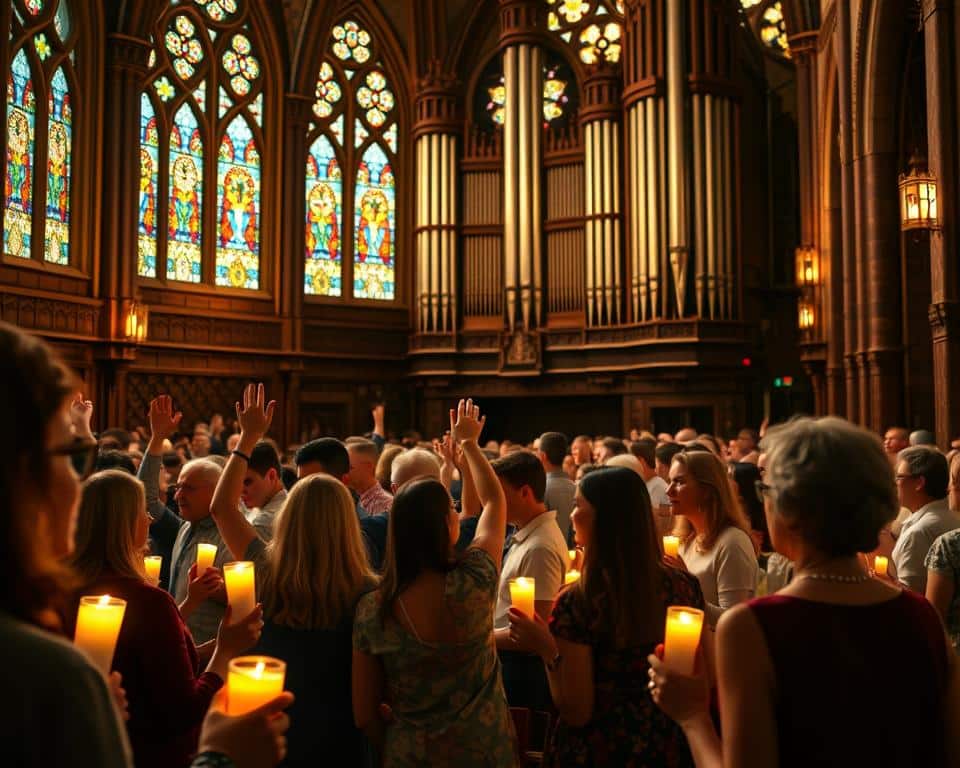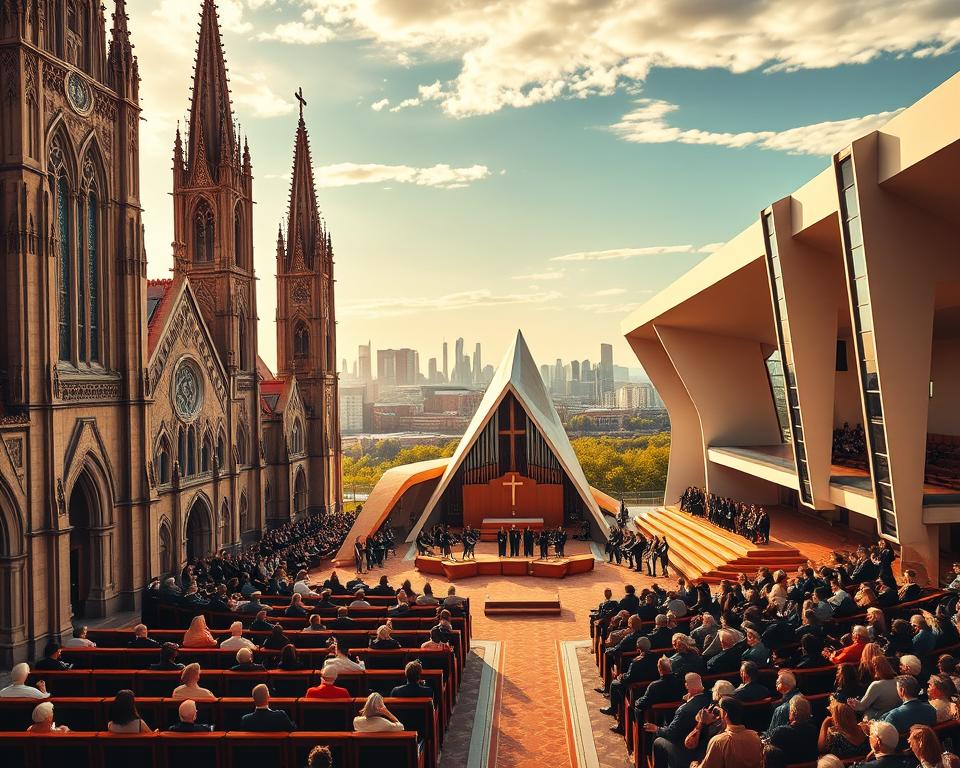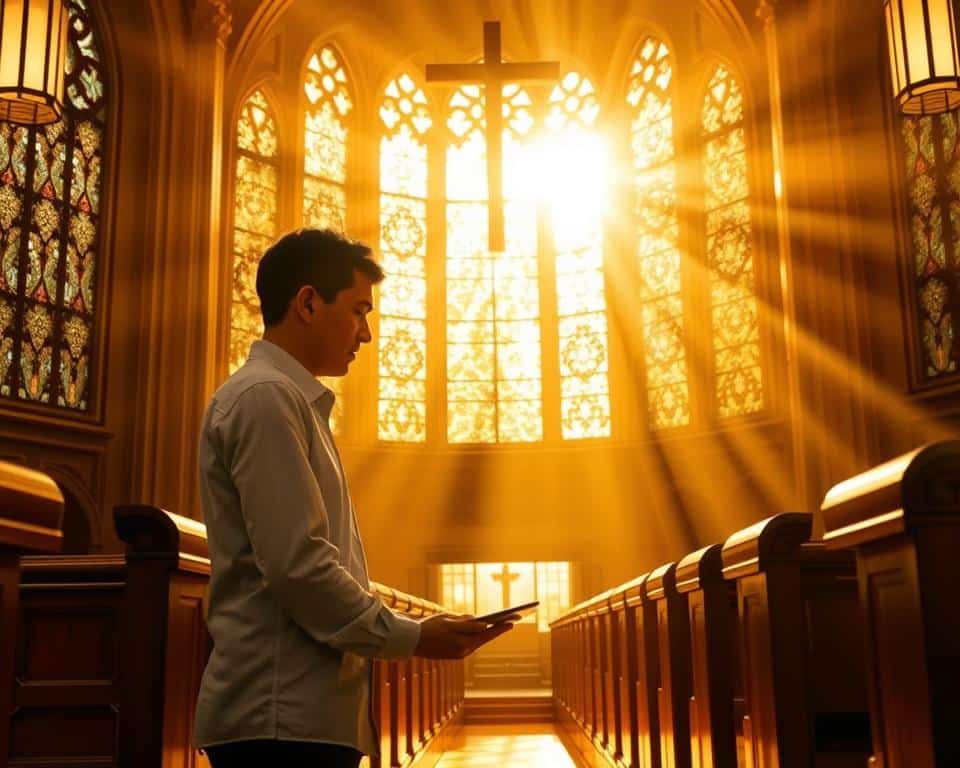“The details are not the details. They make the design.” — Charles Eames. This quote captures the power of intentional spaces. Visual elements shape our experiences, even in sacred settings.
When you step into a place of faith, what do you see? Colors, symbols, and light guide your focus. Scripture reminds us in Exodus 25:8-9 that God cares about sacred spaces. He gave precise instructions for crafting a place of reverence.
Some prefer simplicity—clean lines and minimal distractions. Others feel drawn to rich textures and layered symbolism. Both approaches can deepen connection when rooted in truth. The right balance helps hearts turn toward prayer and reflection.
First impressions matter. A welcoming space sets the tone for engagement. Thoughtful design isn’t about spectacle. It’s about creating an environment where faith grows.
The Role of Church Decorations and Worship
From Solomon’s Temple to modern sanctuaries, beauty points to truth. Thoughtful design isn’t about distraction—it’s a roadmap for the soul. When every detail reflects God’s character, spaces become vessels for encounter.
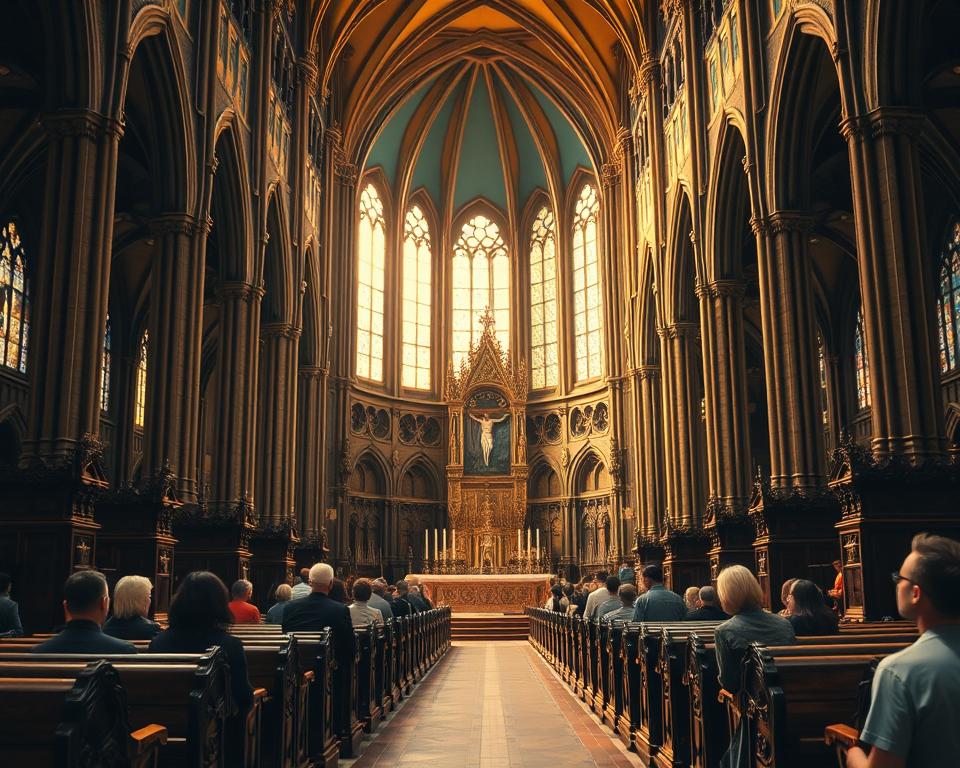
How Decor Influences Spiritual Focus
Colors whisper messages. Purple altar cloths during Advent signal preparation for Christ’s birth. Like stained glass, they filter light into meaning.
Scripture shows this intentionality. The tabernacle’s gold cherubim (Exodus 25:18) weren’t art—they were reminders of heaven’s nearness. Today, unbleached linen on communion tables echoes Levitical purity.
Biblical Perspectives on Sacred Spaces
1 Kings 6 describes cedar carvings and gold overlays in Solomon’s Temple. Yet Revelation 21:2 paints the New Jerusalem as the ultimate sacred space—no sun needed, for God’s glory lights it.
Balance matters. Exodus 20:4-5 warns against idolatry. Decor should lift eyes to God, not trap them in craftsmanship.
In churches, design fosters prayer. A starry dome or marble aisle isn’t extravagance—it’s an invitation to awe.
Essential Elements of Church Decor
Light shapes more than vision—it guides the heart toward reflection. Thoughtful design blends color and illumination to create spaces where faith deepens. Whether through stained glass or simple candles, every detail can point to truth.
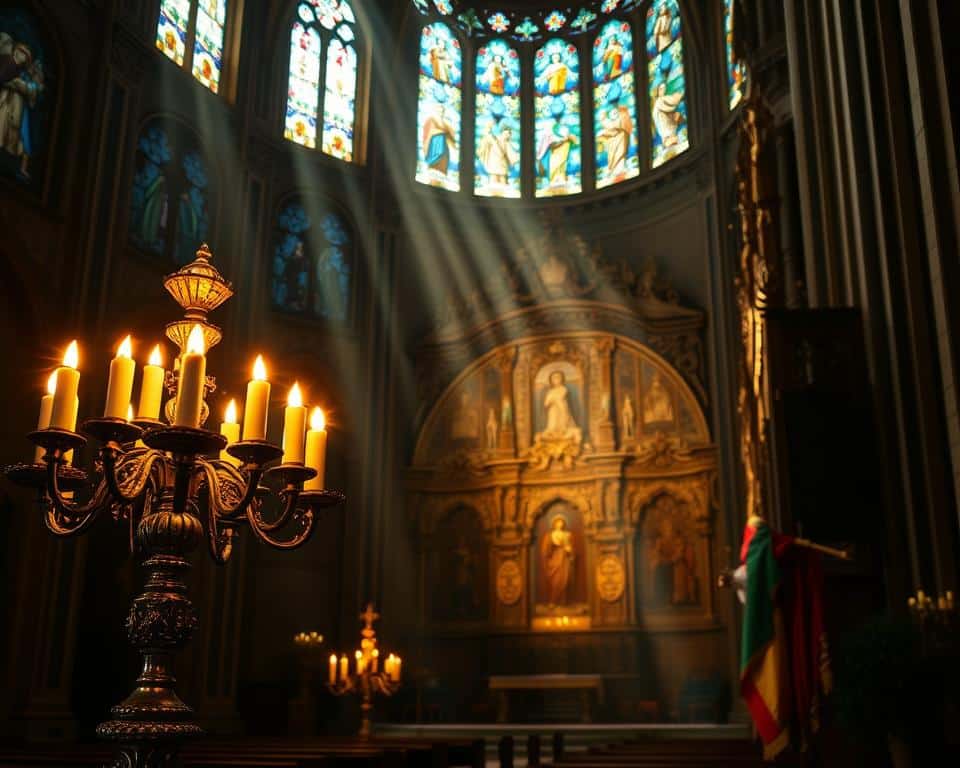
Choosing Colors for Liturgical Seasons
Colors speak without words. Purple during Advent whispers of preparation, while white at Easter shouts resurrection joy. Scripture shows this intentionality—gold in the tabernacle symbolized God’s presence (Exodus 25:11).
Consider these principles:
- Warm hues like red or orange uplift praise moments.
- Cool tones like blue or purple foster quiet reflection.
- Use natural fabrics—unbleached linen for communion tables echoes Levitical purity.
Lighting Techniques for Reverent Ambiance
Lighting sets the mood. Dimmable LED systems adjust for sermons or prayer. Recessed lights highlight stained glass without glare. A cross-shaped display with warm backlighting can symbolize divine nearness.
Practical tips:
- Match lumen output to your sanctuary size—soft for small chapels, brighter for large halls.
- Programmable LED systems ease transitions between service segments.
- Always keep emergency exits illuminated for safety.
“Let your light shine before others, that they may see your good deeds and glorify your Father in heaven.” — Matthew 5:16
Balance matters. Lights should enhance, not distract. Like the star over Bethlehem, design points the way to Christ.
Altar Decorations That Inspire Devotion
The altar stands as the heart of sacred gatherings, where design meets devotion. Every choice—from fabrics to florals—can turn a simple table into a focal point for prayer. Scripture reminds us in Genesis 28:17 that certain spaces become “the house of God.” Thoughtful details honor that truth.
Floral Arrangements for the Altar
Fresh flowers breathe life into worship. White roses and greenery evoke purity, while seasonal blooms reflect God’s faithfulness through the year. A three-tiered candle stand can symbolize the Trinity, its flames echoing Christ’s light.
- Place offering plates on cloths embroidered with Isaiah 6:8 (“Here am I; send me”).
- Use wooden ark replicas to teach children about God’s promises.
Symbolic Items to Highlight the Sacred
An open Bible on an acrylic lectern invites transparency. Empty crosses, preferred by some faith traditions, point to resurrection hope. Metal cross signs or draped liturgical banners can frame the space without distraction.
Simple touches matter most. A single olive branch whispers peace, while a dove sculpture reminds us of the Spirit’s presence. Like the tabernacle’s gold cherubim, these symbols lift eyes toward heaven.
Creative Wall and Ceiling Treatments
Walls and ceilings hold untapped potential to elevate sacred moments. Like the tabernacle’s woven tapestries (Exodus 26:1), textured surfaces can guide hearts toward prayer. Simple changes—a stenciled Scripture or draped fabric—turn blank spaces into reflections of God’s truth.
Textured Backdrops for Visual Depth
3D wall panels add shadow play, making light dance like David’s praise (2 Samuel 6:14). For smaller spaces, mosaic tiles in earth tones create warmth. Celtic stencils or projected Scripture verses offer customizable messages that adapt to seasons.
Safety matters. Choose fire-retardant fabrics for draped backdrops. Involve your youth group in painting murals—their creativity breathes life into shared spaces.
Banners with Scripture and Symbols
Fabric banners proclaim hope without words. Pentecost designs with flame shapes remind us of the Spirit’s fire. For Easter, glow-in-the-dark thread whispers “He Is Risen” in the dark.
Store banners rolled in acid-free tubes to preserve colors. Hang multilingual John 3:16 designs to welcome diverse hearts. Like Bezalel’s craftsmanship (Exodus 35:30), every stitch can point to Christ.
Seating Arrangements for Comfort and Community
How you sit shapes how you connect—both with others and with God. A well-planned room fosters unity, whether through semicircular pews or flexible chairs. Like the early believers in Acts 2:42, face-to-face seating encourages shared testimonies and prayers.
Prioritize accessibility. Aisles should span at least 36 inches for wheelchair access, reflecting Christ’s heart for inclusion. Chair cushions with pockets hold hymnals, keeping hands free for worship. Color-coded seat covers mark family sections, creating safe spaces for all ages.
Practical touches matter. Hearing loop systems under pews ensure everyone catches God’s word clearly. Movable chairs adapt to events—hay bales for harvest services, or circles for small-group discussions. As Proverbs 15:22 reminds us, plans succeed with counsel.
“Let us consider how we may spur one another on toward love and good deeds, not giving up meeting together.” — Hebrews 10:24–25
Every chair tells a story. Whether it’s a cushioned pew or a folding seat, design your space to build community. When comfort meets intentionality, hearts open to truth.
Seasonal Church Decor Ideas
Seasons change, and so can your sacred space—each holiday brings fresh ways to reflect God’s story. Whether it’s evergreen boughs whispering of eternal life or lilies proclaiming resurrection, thoughtful details turn celebrations into teachable moments. Let’s explore how to honor these sacred times through design.
Christmas: Nativity Scenes and Evergreens
Advent calls for warmth and anticipation. Poinsettias in rich reds point to Christ’s sacrifice, while evergreen garlands symbolize God’s unchanging love. A wooden manger scene becomes a focal point for family devotions.
Try these ideas:
- Mirrored trays beneath candleholders multiply light, echoing Bethlehem’s star.
- Olive branch wreaths on doors whisper peace, tying to Jesus’ Gethsemane prayers.
- Dove sculptures nestled in greenery remind us of the Spirit’s role in Christ’s birth.
Easter: Fresh Flowers and White Linens
Resurrection Sunday deserves a canvas of hope. Drape communion tables with white linen, mirroring Christ’s burial cloth left empty. Hyacinth bulbs in clear vases let congregations witness new life sprouting—just like the tomb’s victory.
Symbolic touches matter:
- Arrange lilies near the pulpit, their trumpet shapes heralding Jesus’ triumph.
- Wheatgrass centerpieces grow visibly through Holy Week, a living metaphor.
- Sunrise-hued LED strips behind crosses create a dawn-like glow during sunrise services.
“He is not here; he has risen!” — Luke 24:6
Wedding Decorations in Sacred Spaces
Weddings transform sacred spaces into stories of covenant love. Every detail—from aisle runners to altar drapes—can reflect God’s faithfulness. Thoughtful design honors the solemnity of vows while celebrating joy.
Aisle Runners and Pew Markers
A fabric runner turns an aisle into a path of promise. Choose wrinkle-resistant materials for destination weddings, ensuring beauty survives shipping. Pew markers with olive branches whisper peace, tying to Scripture’s imagery.
Coordinate with local bridal shops for rental partnerships. This saves costs and supports community businesses. Tension rods protect historic architecture while securing delicate fabrics.
Altar Drapes for Elegant Ceremonies
An altar draped in linen becomes a canvas for covenant vows. Polyester blends resist wrinkles, ideal for humid climates. For heirloom touches, weave family lace into new designs.
Frame marriage license tables with flowing drapes. This creates a photo-worthy moment. Like Rebecca at the well (Genesis 24), let details point to God’s providence.
“Therefore what God has joined together, let no one separate.” — Mark 10:9
Keep colors timeless. Ivory or white fabrics mirror purity, while gold accents echo heavenly glory. Every choice should lift eyes to the Giver of love.
Funeral and Memorial Service Decor
Funeral services offer a sacred space to celebrate life and faith. Simple touches—like white flowers or soft candlelight—can turn grief into moments of hope. Scripture reminds us in John 11:25 that Christ is “the resurrection and the life.” Thoughtful design honors this truth.
Create a memory table with photo collages on easels. Weighted balloon anchors replace helium releases, protecting wildlife. For a living tribute, print memorial cards on seed paper—guests plant them as symbols of new life.
Lighting matters. LED candles with drip-catching trays ensure safety during shared moments. Place grief resource pamphlets in floral arrangements, offering comfort beyond the service.
“He will wipe every tear from their eyes. There will be no more death or mourning or crying or pain.” — Revelation 21:4
Two arrangements of white flowers near the altar symbolize resurrection. Floral sprays from loved ones can be sent home, keeping the focus on worship. Every detail should point to eternal hope.
Technology in Modern Church Decor
Technology reshapes how we experience sacred moments, blending innovation with timeless truth. Digital tools now amplify faith in ways the early believers never imagined. Like Bezalel’s craftsmanship in Exodus 31, today’s tech can point hearts toward God’s glory.
LED Walls for Dynamic Displays
Curved or circular LED walls create immersive visual journeys. These screens offer crisp views from any angle—perfect for large gatherings. Imagine Ezekiel’s wheeled visions (Ezekiel 1:15-21) animated during prophecy studies.
Global installations prove their impact. Seamless splicing ensures no distracting gaps. Use them to display:
- Song lyrics with nature backdrops
- Sermon notes alongside historical Bible maps
- Real-time prayer requests during intercession
Projection Mapping for Immersive Worship
Walls become art with projection mapping. Transport kids to the Holy Land through virtual tours. Star patterns during creation-themed services mirror Psalm 19:1’s declaration of God’s handiwork.
For sensory-inclusive worship, pair projections with haptic feedback seats. Feel the Jordan River’s current during baptismal sermons. Every detail should point to truth, not spectacle.
“Great are the works of the Lord; they are pondered by all who delight in them.” — Psalm 111:2
Tech isn’t about replacing tradition—it’s about deepening engagement. Whether through LED strings or interactive options, let innovation serve faith.
Natural Elements in Church Design
Nature speaks of God’s creativity, and bringing its elements into sacred spaces deepens our connection to Him. Genesis 2:9 describes Eden’s trees as “pleasing to the eye and good for food”—a model for intentional design. When we use creation’s textures in worship spaces, they become silent sermons about the Creator.
Using Plants and Greenery
Living walls transform blank spaces into breathable art. Moss installations need no sunlight, making them perfect for windowless areas. Potted olive trees near pulpits remind us of Gethsemane’s prayers.
Try these fresh approaches:
- Rotate seasonal blooms to reflect God’s faithfulness through the year
- Hang air plants in geometric terrariums for modern symbolism
- Use wheatgrass centerpieces during harvest festivals
Wood and Stone for Earthy Warmth
Exodus 25:10 shows God specifying acacia wood for the ark—a reminder that humble materials can hold holiness. Today, reclaimed barn beams make sturdy pulpits, while quarry offcuts form budget-friendly baptism fonts.
Local artisans can craft:
- Ten Commandment tablets from regional timber
- Missionary timeline markers with inlaid river stones
- FSC-certified pews that steward creation responsibly
“The heavens declare the glory of God; the skies proclaim the work of his hands.” — Psalm 19:1
Lemon oil polished Bibles release subtle fragrance when opened—a sensory reminder of God’s living Word. Every natural detail should point to His craftsmanship.
Children’s Area Decor for Engagement
Little hands need big inspiration—thoughtful spaces shape young faith. Proverbs 22:6 reminds us to “train up a child,” and your design can help. Bright colors and interactive elements turn lessons into adventures.
Transform floors into Paul’s missionary journeys with painted maps. Kids trace his steps with their fingers, connecting geography to God’s work. Velcro storyboards let them rebuild Noah’s ark or David’s slingshot—learning through touch.
Wipe-clean murals make Scripture practice fun. Each week, add a new verse in bold letters. Cloud-shaped bookshelves hold Bible stories at eye level, inviting exploration.
Label toy bins with the Fruits of the Spirit. A “kindness bin” for stuffed animals or a “peace corner” with bean bags teaches values. Animal-print cushions add comfort while reinforcing creation truths.
“Jesus said, ‘Let the little children come to me.’” — Matthew 19:14
Use chalkboards for thankful drawings or themed hallways for immersive journeys. Every detail should whisper God’s love. In your church, let decor spark joy and truth in young hearts.
Outdoor Church Decorations
The journey toward truth begins before stepping inside. Your property’s design sets the tone for faith encounters. Isaiah 35:8 calls it “the Way of Holiness”—a path prepared for seekers. Thoughtful outdoor elements guide hearts toward reverence.
Lighting matters. Solar-powered pathway markers create safe walks for evening services. They echo Psalm 119:105’s promise: “Your word is a lamp for my feet.” Consider warm LED strings in trees for festive glow without glare.
Welcome Signs and Pathway Lights
Update your main entrance seasonally. A chalkboard sign with weekly Scripture invites engagement. For permanence, laser-cut metal lasts decades. Include braille plates for inclusive messaging.
Frame walkways with native plants. Local foliage teaches stewardship while cutting maintenance costs. Marigolds during Passover week mirror biblical dyes. Lavender near benches offers calming fragrance.
Seasonal Wreaths for Church Entrances
Rotate wreaths to mark sacred time. Palm Sunday designs with olive branches recall Jesus’ entry. Pentecost options might feature red ribbons swirling like flames.
- Host wreath-making workshops before Advent
- Use memorial wreaths as compost for new life symbolism
- Display harvest cornucopias with donation baskets underneath
“I am the gate; whoever enters through me will be saved.” — John 10:9
Budget-Friendly Decor Solutions
Creativity thrives when resources are limited—your sacred space can shine without straining finances. Like the boy’s loaves and fish (John 6:9), God multiplies our humble offerings into meaningful impact.
Start with reusable fabrics. Durable linen altar cloths can transition from Advent purple to Easter white with simple overlays. PVC piping makes sturdy puppet stages for youth programs—paint them to match your VBS theme.
Build community through swap events. Neighboring congregations might trade floral arrangements or banners seasonally. One church’s Christmas garland becomes another’s Pentecost decoration.
Consider these cost-effective options:
- Barter cleaning services with local florists for fresh centerpieces
- Apply for arts council grants to fund mural projects
- Repurpose wedding arches as Bible story backdrops
Even small touches matter. A warm beverage station with donated mugs creates fellowship. Handprint borders around classrooms turn children into co-creators. When we steward resources wisely, every detail points to God’s provision.
Safety Considerations for Church Decor
Safety and accessibility aren’t afterthoughts—they’re acts of love for every worshiper. Psalm 82:3-4 urges us to “defend the weak” and “maintain the rights of the poor.” This includes creating spaces where all can focus on truth without physical barriers.
Choosing Fire-Resistant Materials
Flame-retardant fabrics protect lives while maintaining beauty. Look for draperies with NFPA 701 certification—they resist ignition without chemical odors. Keep exits clear with wall-mounted decor instead of freestanding pieces.
Practical steps for safety:
- Place fire extinguishers every 75 feet, marked with high-contrast signs
- Use battery-operated candles near flammable materials
- Train volunteers to monitor emergency routes during crowded events
Designing Accessible Layouts
An inclusive space reflects God’s heart for all people. Wheelchair ramps should slope no steeper than 1:12, with tactile paving for navigation. Install braille labels beside permanent artwork for the visually impaired.
Consider these welcoming touches:
- Sensory-friendly worship guides with simplified language
- Designated areas for service animals with water stations
- High-contrast color schemes for better visibility
“Do not withhold good from those to whom it is due, when it is in your power to act.” — Proverbs 3:27
Monthly checks ensure emergency lights function. Test exit signs when daylight saving time changes. When safety and accessibility unite, spaces truly become houses of prayer for all nations.
Collaborating with Your Church Community
Shared creativity builds stronger bonds of faith. When your community designs together, spaces reflect collective hope. Like Nehemiah’s workers (Nehemiah 4:6), each person’s contribution matters.
Start with a planning potluck. Invite ideas while sharing meals—food fuels creativity. Teens might sketch murals; seniors could stitch banners. Every generation brings unique gifts.
Try these inclusive approaches:
- Pinterest boards let members pin inspiration remotely
- Monthly “decor swaps” with neighboring congregations save costs
- Seed paper name tags grow into flowers—symbolizing shared growth
Publicly thank volunteers during services. A simple slide with their names honors their time. Document seasonal transitions in a shared folder. Photos and checklists keep teams aligned.
“Two are better than one… for if they fall, one will lift up the other.” — Ecclesiastes 4:9–10
Survey cultural preferences. A Korean member might suggest hanji paper lanterns; another could share harvest festival traditions. Unity blooms when all voices shape the space.
Final Thoughts on Decorating for Worship
Every space tells a story—make yours reflect God’s truth. When planning your church design, let each element point to Christ. Beauty matters, but purpose matters more.
Good decor serves the heart of worship. It reminds us of Scripture without distracting from it. Like the tabernacle’s gold, details should whisper heaven’s nearness.
Check your space regularly. Faded banners or dim lighting can hinder focus. Ask: “Does this help people encounter truth?”
Remember Jesus’ words about eternal treasures (Matthew 6:19-20). Invest in designs that outlast trends. Most importantly, pray over every change—let God guide your hands.

